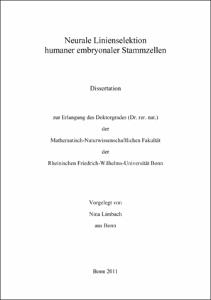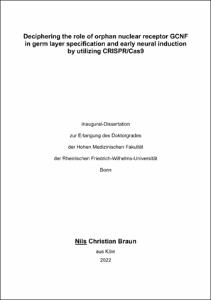Stappert, Laura: MicroRNAs and orphan nuclear receptor GCNF as novel regulators of human neural stem cell differentiation and neuronal subtype specification. - Bonn, 2015. - Dissertation, Rheinische Friedrich-Wilhelms-Universität Bonn.
Online-Ausgabe in bonndoc: https://nbn-resolving.org/urn:nbn:de:hbz:5n-41627
Online-Ausgabe in bonndoc: https://nbn-resolving.org/urn:nbn:de:hbz:5n-41627
@phdthesis{handle:20.500.11811/6547,
urn: https://nbn-resolving.org/urn:nbn:de:hbz:5n-41627,
author = {{Laura Stappert}},
title = {MicroRNAs and orphan nuclear receptor GCNF as novel regulators of human neural stem cell differentiation and neuronal subtype specification},
school = {Rheinische Friedrich-Wilhelms-Universität Bonn},
year = 2015,
month = oct,
note = {MicroRNAs (miRNAs) are currently recognized as important regulators of neural development. However, given the large number of miRNA species in existence, our understanding of miRNA-based regulation during neurogenesis remains incomplete, in particular with regard to human neural development. Human pluripotent stem cell (hPSC)-based neural stem cells (NSCs) now offer the possibility to study the function of miRNAs in association with early human neuronal differentiation. Thus, the aim of this study was to analyze the impact of miRNAs and their downstream effectors on human neuronal differentiation and subtype specification using a specific population of long-term self-renewing neuroepithelial-like stem (lt-NES) cells.
First, a miRNA profiling analysis was performed covering the progression from human embryonic stem cells to neurons with lt-NES cells as a stable intermediate. Subsequent functional analyses demonstrated that miR-153, miR-181a/a* and miR-324-5p/3p are able to promote neuronal differentiation of lt-NES cells, similar to the impact of the neuronal-associated miR-124 and miR-125b. In addition, miR-124, miR-125b and miR-181a/a* were found to modulate the neuronal subtype composition of differentiating lt-NES cells, and transfection with respective miRNA oligonucleotides induced differentiation towards a dopaminergic phenotype. Further experiments using hPSC-derived floor plate progenitor cells, a more authentic source for midbrain dopaminergic neurons, confirmed the positive function of miR-181a and the negative function of miR-124 during dopaminergic differentiation. The last part of the thesis focused on deciphering the targets and down-stream effectors of miR-181a. With regard to its role as promoter of neuronal differentiation, miR-181a down-regulates several factors involved in NSC maintenance, including the orphan nuclear receptor GCNF. GCNF is a known transcriptional repressor of pluripotency genes, however, evidence collected in this work points to a yet unrecognized role for GCNF in human NSCs. Specifically, direct targeting of GCNF by miR-181a resulted in an increased rate of neuronal differentiation. Conversely, GCNF overexpression interfered with neuronal differentiation, while preserving the characteristic neural rosette morphology of undifferentiated lt-NES cells. On a mechanistic level, GCNF might act as a suppressor of pro-neural bHLH gene expression, similar to the role of Notch signaling. Indeed, ectopic expression of GCNF partially compensated for Notch inhibition by the gamma-secretase inhibitor DAPT. In addition to this general effect on neuronal differentiation, GCNF has a specific negative effect on the dopaminergic lineage. Thus, the action of miR-181a on GCNF might also account for the miR-181a-induced dopaminergic differentiation. Overexpression of miR-181a in lt-NES cells also increased Wnt activity, which might further contribute to the generation of dopaminergic neurons.
Taken together, this work describes a comprehensive analysis from miRNA profiling to the functional study of specific miRNAs in the context of human neuronal differentiation. Based on these analyses, a mechanistic interaction between miR-181a and GCNF in regulating human NSC fate was discovered. Furthermore, this study is the first to describe a miRNA – miR-181a – that promotes the generation of dopaminergic neurons. These findings could be exploited to develop novel approaches for human neural stem cell maintenance as well as the in vitro differentiation of dopaminergic neurons.},
url = {https://hdl.handle.net/20.500.11811/6547}
}
urn: https://nbn-resolving.org/urn:nbn:de:hbz:5n-41627,
author = {{Laura Stappert}},
title = {MicroRNAs and orphan nuclear receptor GCNF as novel regulators of human neural stem cell differentiation and neuronal subtype specification},
school = {Rheinische Friedrich-Wilhelms-Universität Bonn},
year = 2015,
month = oct,
note = {MicroRNAs (miRNAs) are currently recognized as important regulators of neural development. However, given the large number of miRNA species in existence, our understanding of miRNA-based regulation during neurogenesis remains incomplete, in particular with regard to human neural development. Human pluripotent stem cell (hPSC)-based neural stem cells (NSCs) now offer the possibility to study the function of miRNAs in association with early human neuronal differentiation. Thus, the aim of this study was to analyze the impact of miRNAs and their downstream effectors on human neuronal differentiation and subtype specification using a specific population of long-term self-renewing neuroepithelial-like stem (lt-NES) cells.
First, a miRNA profiling analysis was performed covering the progression from human embryonic stem cells to neurons with lt-NES cells as a stable intermediate. Subsequent functional analyses demonstrated that miR-153, miR-181a/a* and miR-324-5p/3p are able to promote neuronal differentiation of lt-NES cells, similar to the impact of the neuronal-associated miR-124 and miR-125b. In addition, miR-124, miR-125b and miR-181a/a* were found to modulate the neuronal subtype composition of differentiating lt-NES cells, and transfection with respective miRNA oligonucleotides induced differentiation towards a dopaminergic phenotype. Further experiments using hPSC-derived floor plate progenitor cells, a more authentic source for midbrain dopaminergic neurons, confirmed the positive function of miR-181a and the negative function of miR-124 during dopaminergic differentiation. The last part of the thesis focused on deciphering the targets and down-stream effectors of miR-181a. With regard to its role as promoter of neuronal differentiation, miR-181a down-regulates several factors involved in NSC maintenance, including the orphan nuclear receptor GCNF. GCNF is a known transcriptional repressor of pluripotency genes, however, evidence collected in this work points to a yet unrecognized role for GCNF in human NSCs. Specifically, direct targeting of GCNF by miR-181a resulted in an increased rate of neuronal differentiation. Conversely, GCNF overexpression interfered with neuronal differentiation, while preserving the characteristic neural rosette morphology of undifferentiated lt-NES cells. On a mechanistic level, GCNF might act as a suppressor of pro-neural bHLH gene expression, similar to the role of Notch signaling. Indeed, ectopic expression of GCNF partially compensated for Notch inhibition by the gamma-secretase inhibitor DAPT. In addition to this general effect on neuronal differentiation, GCNF has a specific negative effect on the dopaminergic lineage. Thus, the action of miR-181a on GCNF might also account for the miR-181a-induced dopaminergic differentiation. Overexpression of miR-181a in lt-NES cells also increased Wnt activity, which might further contribute to the generation of dopaminergic neurons.
Taken together, this work describes a comprehensive analysis from miRNA profiling to the functional study of specific miRNAs in the context of human neuronal differentiation. Based on these analyses, a mechanistic interaction between miR-181a and GCNF in regulating human NSC fate was discovered. Furthermore, this study is the first to describe a miRNA – miR-181a – that promotes the generation of dopaminergic neurons. These findings could be exploited to develop novel approaches for human neural stem cell maintenance as well as the in vitro differentiation of dopaminergic neurons.},
url = {https://hdl.handle.net/20.500.11811/6547}
}









